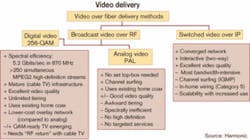RBOCs are banking on video to bolster their service offerings
Since the summer of 2003, Verizon, SBC, and BellSouth have announced differing approaches to fiber deployment for the delivery of high-speed data, voice, and video to end users. Until relatively recently, the carriers had remained somewhat quiet on the video portion of their triple-play strategies, but new details about their technology choices and deployment schedules have emerged.
Verizon has begun deploying an all-fiber network, while SBC and BellSouth are installing fiber to the node (FTTN) and curb (FTTC), respectively, then running copper to the residence. “Fiber is going to figure into a lot of the video solutions, regardless of whether copper is used for the last few hundred or thousand feet,” asserts Jay Fausch, senior director of strategic marketing for the Fixed Communications Group of Alcatel (Paris).
The RBOCs have decided to enter the video services business in response to the competitive threat to the voice side of their business. “With wireless and broadband and competition from VoIP, they see shrinking market share for voice access lines, their bread-and-butter business,” explains Lawrence K. Vanston, president of Technology Futures (Austin, TX). “Our forecasts certainly indicate they will decline even more dramatically in the future.”A business model based solely on the delivery of voice service is no longer sustainable. If the ILECs want to stay in the residential landline telecommunications business, they must find a way to compete more effectively with the triple-play offerings of the cable multiple-system operators (MSOs).
“The cable TV MSOs have for years been aggressively competing with the ILECs in the broadband Internet access market and now are gearing up to launch VoIP services that will directly target the telco’s core telephone business,” reports David Hold, senior analyst of network services with Current Analysis (Sterling, VA). “If carriers...do not expand their range of offerings, they risk becoming marginalized by the full-service offerings of the cable operators.”
The RBOCs will choose between two basic mechanisms for the delivery of video services: radio frequency (RF) overlay and switched digital video. Both techniques have their advocates and detractors, and there are risks and rewards associated with each.
Though it has not publicly discussed its video deployment plans, Verizon appears to favor an RF overlay method in which a dedicated wavelength is used to provide video services using RF technology. This technique enables Verizon to deliver video content in the same format that a cable TV or satellite provider might use. Last October, Verizon tapped Motorola to provide video-network infrastructure and video consumer premises equipment.
There are three basic pieces of equipment necessary for the delivery of video services over an RF overlay network, says David Piehler, vice president of the FTTP business unit of Harmonic (Sunnyvale, CA). At the optical-network terminal (ONT), located at the customer premises, there needs to be an additional RF receiver to receive the third, video-only wavelength. “Basically, you just take the output of that receiver and plug it directly into a standard television set,” explains Piehler. “That’s one of the big advantages. You can serve multiple TVs throughout the house using your existing coaxial wiring in the house, and you don’t need to buy a special set-top box for every TV.”
A special video optical line terminal (OLT), the counterpart of the PON OLT, is also required and consists of a video transmitter and an optical amplifier. The video transmitter takes standard cable TV content over a coaxial cable and converts it into cable TV-like signals over the 1550-nm wavelength. An amplifier boosts and splits the signal, and a WDM multiplexer then multiplexes that video signal over the same fiber as the data and voice signal. “What you have is the video signal going downstream at 1550 nm, the data signal from the OLT going downstream at 1490 nm, and each home having a Fabry-Perot laser that sends signals back to the OLT at 1310 nm,” says Piehler.
A key benefit of the RF overlay model is its ability to deliver plenty of bandwidth. Using RF video overlay, a carrier can deliver 5.2 Gbits/sec of bandwidth into every residence, which is enough bandwidth to support 250 streams of high definition TV. Flexibility is another benefit, since video overlay can be used with all the various flavors of PON, including broadband PON, gigabit PON, and Ethernet PON.
The RF overlay does have its limitations, however. The technology is ideal for broadcasting video content where each consumer receives the same content, particularly a PON point-to-multipoint topology. But for targeted content delivery or video on demand, RF overlay is not the best delivery mechanism.
For this reason, Verizon plans to use a combination of RF video overlay and switched digital video, Piehler says. “What Verizon is doing is actually a hybrid technique where the broadcast video is carried on the RF overlay and the targeted video content, the video on demand or ultra-narrowcast, is carried on the IP part of the network,” reports Piehler.
Basic RF overlay “is sort of the old way of doing things,” claims Alcatel’s Fausch. Alcatel recently received a $1.7-billion contract from SBC to provide FTTP and FTTN equipment for the carrier’s Project Lightspeed initiative, which uses a switched digital video mechanism for the delivery of video services.
Lightspeed’s FTTN approach delivers fiber to within a few hundred or few thousand feet of the residence, allowing SBC to deliver 20-25 Mbits/sec into people’s homes, more than enough bandwidth to support IP-based video, high-speed data, and VoIP all on one pipe, says Denise Koenig, SBC spokesperson. Lightspeed will be a true routed IP-based network, and all services delivered over it will be IP-based. That includes video; the carrier recently inked a 10-year, $400-million deal with Microsoft for the use of the company’s IPTV software and middleware.“With IP video, there are a host of unique services and service modifiers you could do,” says Fausch. “For example, you could integrate telephony with video, being able to see caller ID on your TV as you’re watching it. From a video standpoint, IP gives you the ability to do things like change camera angles on a video on demand system. The hope that SBC has in going in the direction of IP is that it will essentially allow them to deliver not just a ‘me too’ solution but rather a unique video service.”
The IP-based switched digital approach delivers video in-band; video is carried over the same path that carries both the voice and data services. With the RF overlay model, all the video content must reside on the customer’s set-top box, using all the bandwidth going into the home, says Koenig. “We’re using an IP-based streaming model, so all the content is actually going to reside on our servers. We’re only going to send to the customer what the customer is requesting.”
The switched digital video delivery mechanism is particularly effective at point-to-point content delivery, sending a specific program to specific residences in a video on demand format. However, the technology begins to break down when it tries to imitate a point-to-multipoint RF broadcast service.
The limitations of IP video have led carriers like SBC to adopt temporary measures until the technology matures, like partnering with satellite TV providers. “I think they want to move toward providing video over either their FTTN network or, in the case of BellSouth, FTTC,” asserts Vanston of Technology Futures. “Many people, including myself, think video over IP will be the dominant video delivery mechanism in the future.”
For his part, Fausch remains bullish on the ability to deliver video services over a fiber- and copper-based network. “Fiber gives you more then enough capacity when you run that all the way to the home,” says Fausch. “But coupled with DSL in the last several thousand feet, these FTTN architectures are very, very promising. And they potentially give the telco a quicker and maybe slightly less expensive solution for delivering the speeds necessary to provide competitive service.”
According to Vanston, both delivery mechanisms come with their own set of risks and rewards. The Verizon method, for example, requires more capital up-front, “but it gives you more capabilities and probably a faster way to get into new business,” says Vanston. “The SBC approach is less money up-front, but doesn’t do quite as much for you.”
BellSouth, meanwhile, appears to favor a switched digital approach like SBC and will soon complete lab testing of Microsoft’s IPTV hardware and software. Upon successful lab testing, the carrier will expand its trial to set-top boxes within customer premises in select locations. BellSouth will then evaluate further deployment based on the success of this field trial.
From the start, BellSouth has taken more of a “wait and see approach” to broadband service delivery. “SBC has moved faster in selecting and awarding contracts to multiple suppliers for infrastructure and project management, while Verizon is even further ahead, building-out working systems and obtaining cable franchises to conduct market trials in at least two communities,” reports Hold of Current Analysis. “BellSouth has still not yet announced any contract awards at this point in time either to Microsoft or to any of the other responders such as Alcatel, Lucent, and Ericsson, which replied to its IP-based video RFP last fall.”
Meanwhile, SBC intends to have its first video product on the market by the end of the year in select areas, and by the completion of the project in 2008, all 18 million homes and businesses in its Lightspeed footprint will have a video service option if they choose it.
Verizon intends to be even more aggressive. It plans to roll out video service in select areas by the end of the second quarter. “Because we are providing what amounts to broadcast cable, we have to obtain cable franchises by law in order to provide that kind of service,” says Verizon spokesperson Sharon Cohen-Hagar. “We’re in the process of both deploying our network and negotiating cable franchise agreements in various jurisdictions right now.”
Regardless of their timeline for deployment or the mechanism they use for delivery, the RBOCs must make video a key component of their service offerings going forward. “There is a lot of blurring of the service provisioning these days among cable companies and telecom companies,” admits Cohen-Hagar. “We feel strongly that video has to be a strong part of our service offering. We intend to compete with cable [MSOs] on their own ground-but provide a better service.”

